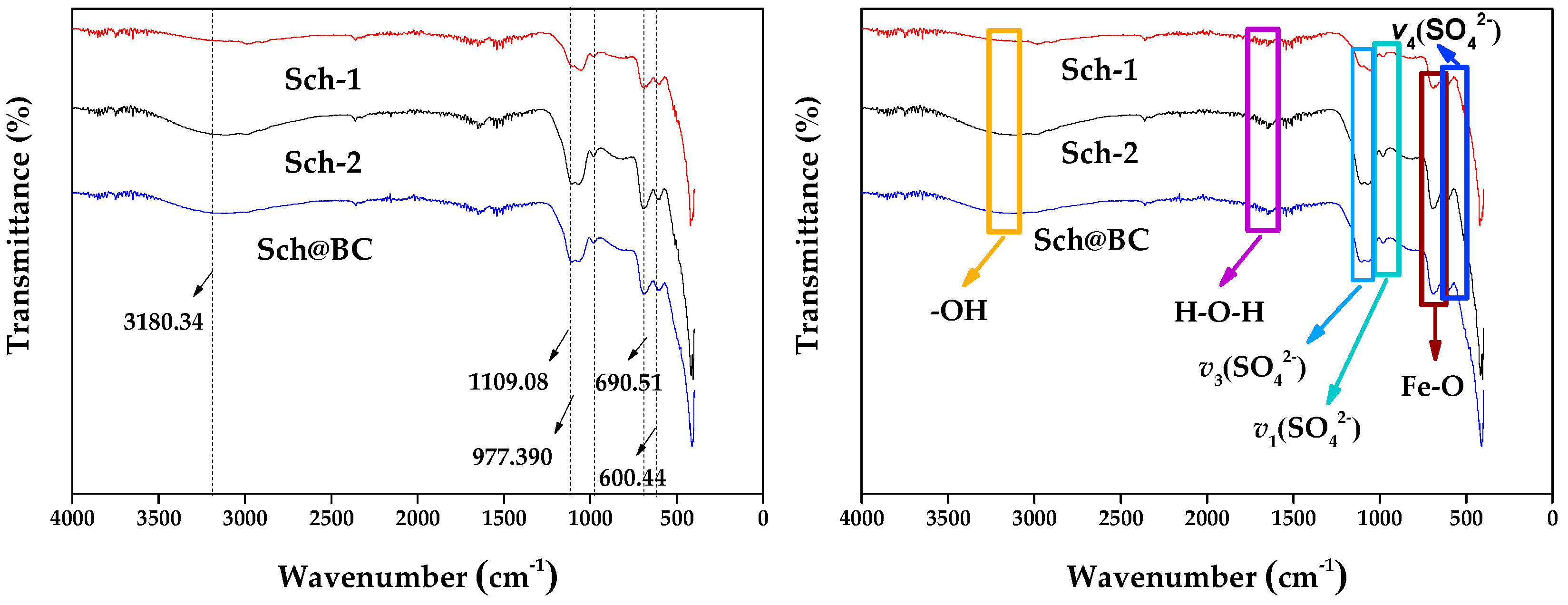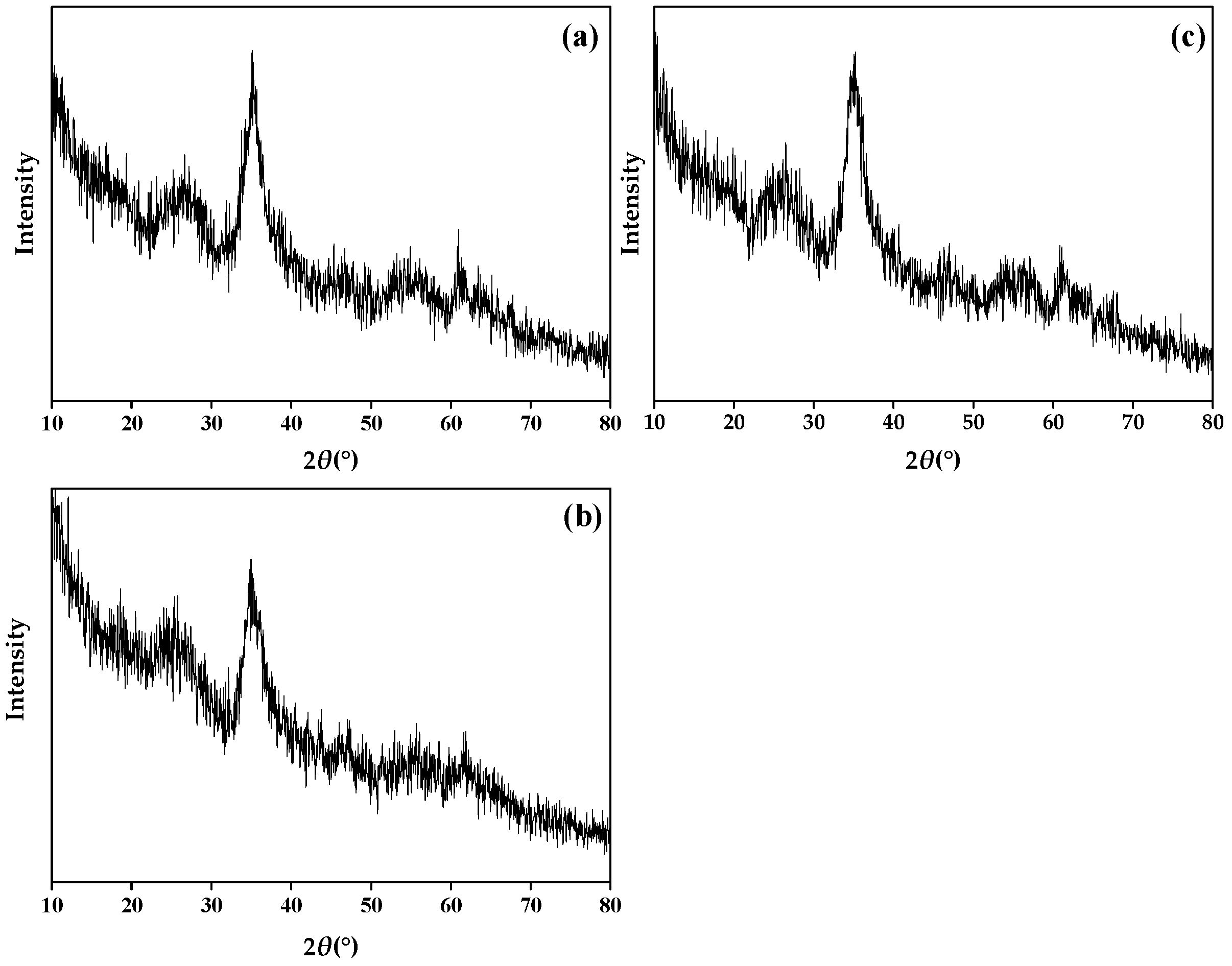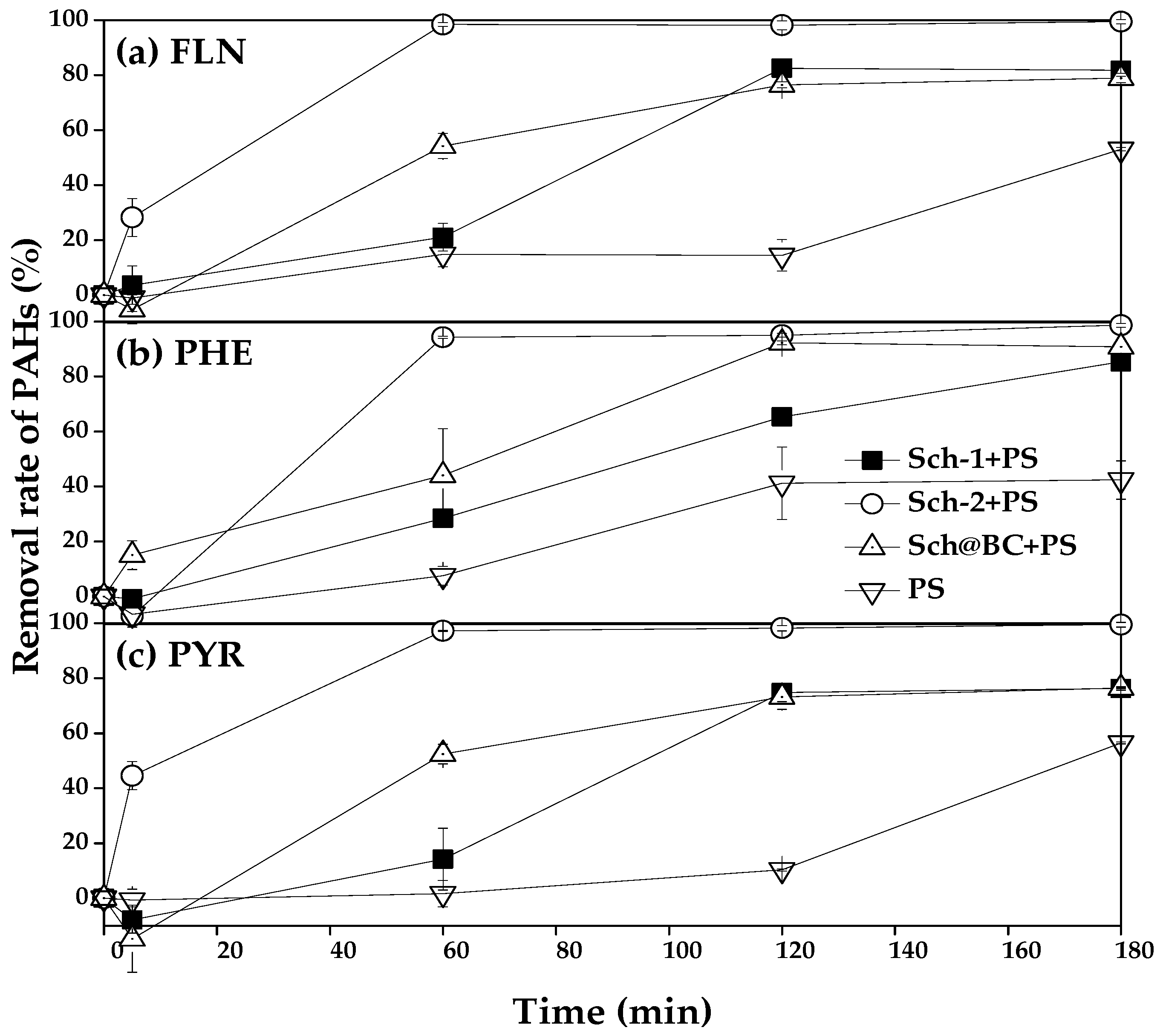A Special Hydrated Iron Oxyhydroxide for Catalyzing Persulfate to Control Chemical Wastewater Containing Fluoranthene, Phenanthrene, and Pyrene
Abstract
1. Introduction
2. Materials and Methods
2.1. Chemical Reagents
2.2. Preparation of Sch with Three Synthesis Methods
- (1)
- sch-1: add 1.8 mL H2O2 at 2 h;
- (2)
- sch-2: add 0.36 mL H2O2 at 2, 14, 26, 38, and 50 h;
- (3)
- sch@BC: add 1.8 mL H2O2 at 2 h, and add biochar (mFe2+:mBC = 1:20) at 3 h.
2.3. Analytical Methods
3. Results
3.1. Characterization of Sch
3.2. Sch with Different Methods Catalyze Persulfate to Control FLN, PHE, and PYR from Simulated Wastewater
4. Discussion
5. Conclusions
Author Contributions
Funding
Data Availability Statement
Acknowledgments
Conflicts of Interest
References
- Wang, J.; Liu, X.; Liu, G.; Zhang, Z.; Cui, B.; Bai, J.; Zhang, W. Size effect of polystyrene microplastics on sorption of phenanthrene and nitrobenzene. Ecotoxicol. Environ. Saf. 2019, 173, 331–338. [Google Scholar] [CrossRef] [PubMed]
- Edokpayi, J.N.; Odiyo, J.O.; Durowoju, O.S. Impact of wastewater on surface water quality in developing countries: A case study of South Africa. In Water Quality; Tutu, H., Ed.; Intech Open: London, UK, 2017. [Google Scholar] [CrossRef]
- Lin, C.; Nguyen, K.A.; Vu, C.T.; Senoro, D.; Villanueva, M.C. Contamination levels and potential sources of organic pollution in an Asian river. Water Sci. Technol. 2017, 76, 2434–2444. [Google Scholar] [CrossRef] [PubMed]
- Grandclement, C.; Seyssiecq, I.; Piram, A.; Wong-Wah-Chung, P.; Vanot, G.; Tiliacos, N.; Roche, N.; Doumenq, P. From the conventional biological wastewater treatment to hybrid processes, the evaluation of organic micropollutant removal: A review. Water Res. 2017, 111, 297–317. [Google Scholar] [CrossRef] [PubMed]
- Rayaroth, M.P.; Marchel, M.; Boczkaj, G. Advanced oxidation processes for the removal of mono and polycyclic aromatic hydrocarbons—A review. Sci. Total Environ. 2023, 857, 159043. [Google Scholar] [CrossRef]
- Uddin, M.M.; Xu, F. Sources, Occurrences, and Risks of Polycyclic Aromatic Hydro-Carbons (PAHs) in Bangladesh: A Review of Current Status. Atmosphere 2024, 15, 233. [Google Scholar] [CrossRef]
- Papadopoulou, P.; Misseyanni, A.; Marouli, C. Current environmental health challenges: Part I—Exposures and research trends. In Handbook of Research on Emerging Developments and Environmental Impacts of Ecological Chemistry; IGI Global: Hershey, PA, USA, 2020; pp. 1–37. [Google Scholar]
- Stejskalova, L.; Dvorak, Z.; Pavek, P. Endogenous and exogenous ligands of aryl hydrocarbon receptor: Current state of art. Curr. Drug. Metab. 2011, 12, 198–212. [Google Scholar] [CrossRef]
- Mojiri, A.; Zhou, J.L.; Ohashi, A.; Ozaki, N.; Kindaichi, T. Comprehensive review of polycyclic aromatic hydrocarbons in water sources, their effects and treatments. Sci. Total Environ. 2019, 696, 133971. [Google Scholar] [CrossRef]
- Olayinka, O.O.; Adewusi, A.A.; Olarenwaju, O.O.; Aladesida, A.A. Concentration of Polycyclic Aromatic Hydrocarbons and Estimated Human Health Risk of Water Samples around Atlas Cove, Lagos, Nigeria. J. Health Pollut. 2018, 8, 181210. [Google Scholar] [CrossRef]
- Zhang, Z.; Gao, B.; He, Z.; Li, L.; Shi, H.; Wang, M. Enantioselective metabolism of four chiral triazole fungicides in rat liver microsomes. Chemosphere 2019, 224, 77–84. [Google Scholar] [CrossRef]
- Adekunle, A.S.; Oyekunle, J.A.O.; Ojo, O.S.; Maxakato, N.W.; Olutona, G.O.; Obisesan, O.R. Determination of polycyclic aromatic hydrocarbon levels of groundwater in Ife north local government area of Osun state, Nigeria. Toxicol. Rep. 2017, 4, 39–48. [Google Scholar] [CrossRef]
- Wang, J.; Zhao, Y.; Sun, J.; Zhang, Y.; Liu, C. The distribution and sources of polycyclic aromatic hydrocarbons in shallow groundwater from an alluvial-diluvial fan of the Hutuo River in North China. Front. Earth Sci. 2019, 13, 33–42. [Google Scholar] [CrossRef]
- Kabzinski, A.K.M.; Cyran, J.; Juszczak, R. Determination of Polycyclic Aromatic Hydrocarbons in Water (Including Drinking Water) of Lodz. Pol. J. Environ. Stud. 2002, 11, 695–706. [Google Scholar]
- Liu, Y.; Shen, J.; Chen, Z.; Ren, N.; Li, Y. Distribution of polycyclic aromatic hydrocarbons in surface water and sediment near a drinking water reservoir in Northeastern China. Environ. Sci. Pollut. Res. 2013, 20, 2535–2545. [Google Scholar] [CrossRef] [PubMed]
- Pan, E.C.; Sun, H.; Xu, Q.J.; Zhang, Q.; Liu, L.F.; Chen, X.D.; Xu, Y. Polycyclic Aromatic Hydrocarbons Concentrations in Drinking Water in Villages along the Huai River in China and Their Association with High Cancer Incidence in Local Population. BioMed Res. Int. 2015, 2015, 762832. [Google Scholar] [CrossRef]
- Nasher, E.; Heng, L.Y.; Zakaria, Z.; Surif, S. Concentrations and Sources of Polycyclic Aromatic Hydrocarbons in the Seawater around Langkawi Island, Malaysia. J. Chem. 2013, 2013, 975781. [Google Scholar] [CrossRef]
- Vijayanand, M.; Ramakrishnan, A.; Subramanian, R.; Issac, P.K.; Nasr, M.; Khoo, K.S.; Rajagopal, R.; Greff, B.; Azelee, N.L.W.; Jeon, B.H.; et al. Polyaromatic hydrocarbons (PAHs) in the water environment: A review on toxicity, microbial biodegradation, systematic biological advancements, and environmental fate. Environ. Res. 2023, 227, 115716. [Google Scholar] [CrossRef]
- Dai, C.; Han, Y.; Duan, Y.; Lai, X.Y.; Fu, R.B.; Liu, S.G.; Leong, K.H.; Tu, Y.J.; Zhou, L. Review on the contamination and remediation of polycyclic aromatic hydrocarbons (PAHs) in coastal soil and sediments. Environ. Res. 2022, 205, 112423. [Google Scholar] [CrossRef]
- Reynoso-Cuevas, L.; Cruz-Sosa, F.; Gutiérrez-Rojas, M. In vitro phytoremediation mechanisms of PAH removal by two plant species. In Polycyclic Aromatic Hydrocarbons: Pollution, Health; Haines, P.A., Hendrickson, M.D., Eds.; Nova Science Publishers: Hauppauge, NY, USA, 2010. [Google Scholar]
- Karaca, G.; Baskaya, H.S.; Tasdemir, Y. Removal of polycyclic aromatic hydrocarbons (PAHs) from inorganic clay mineral: Bentonite. Environ. Sci. Pollut. Res. 2016, 23, 242–252. [Google Scholar] [CrossRef]
- Guo, Y.; Wang, Q.Y. Investigation of Pyrolysis/Gasification Process Conditions and Syngas Production with Metal Catalysts Through Waste Bam-boo Biomass: Effects and Insights. Sustainability 2023, 15, 14588. [Google Scholar] [CrossRef]
- Paszkiewicz, M.; Sikorska, C.; Leszczyńska, D.; Stepnowski, P. Helical multi-walled carbon nanotubes as an efficient material for the dispersive solid-phase extraction of low and high molecular weight polycyclic aromatic hydrocarbons from water samples: Theoretical study. Water Air Soil Pollut. 2018, 229, 253. [Google Scholar] [CrossRef]
- Pandis, P.K.; Kalogirou, C.; Kanellou, E.; Vaitsis, C.; Savvidou, M.G.; Sourkouni, G.; Zorpas, A.A.; Argirusis, C. Key points of advanced oxidation processes (AOPs) for wastewater, organic pollutants and pharmaceutical waste treatment: A mini review. ChemEngineering 2022, 6, 8. [Google Scholar] [CrossRef]
- Gaurav, G.K.; Mehmood, T.; Kumar, M.; Cheng, L.; Sathishkumar, K.; Kumar, A.; Yadav, D. Review on polycyclic aromatic hydrocarbons (PAHs) migration from wastewater. J. Contam. Hydrol. 2021, 236, 103715. [Google Scholar] [CrossRef] [PubMed]
- Tian, H.; Li, C.; Wang, Z.; Zhao, S.; Xu, Y.X.; Wang, S.G. Polycyclic aromatic hydrocarbons degradation mechanisms in methods using activated persulfate: Radical and non-radical pathways. Chem. Eng. J. 2023, 473, 145319. [Google Scholar] [CrossRef]
- Li, N.; Wu, S.; Dai, H.X.; Cheng, Z.J.; Peng, W.C.; Yan, B.B.; Chen, G.Y.; Wang, S.B.; Duan, X.G. Thermal activation of persulfates for organic wastewater purification: Heating modes, mechanism and influencing factors. Chem. Eng. J. 2022, 450, 137976. [Google Scholar] [CrossRef]
- Feng, Y.; Tao, Y.; Meng, Q.; Qu, J.; Ma, S.; Han, S.; Zhang, Y. Microwave-combined advanced oxidation for organic pollutants in the environmental remediation: An overview of influence, mechanism, and prospective. Chem. Eng. J. 2022, 441, 135924. [Google Scholar] [CrossRef]
- Zheng, X.; Niu, X.; Zhang, D.Q.; Lv, M.Y.; Ye, X.Y.; Ma, J.L.; Lin, Z.; Fu, M.L. Metal-based catalysts for persulfate and peroxymonosulfate activation in heterogeneous ways: A review. Chem. Eng. J. 2022, 429, 132323. [Google Scholar] [CrossRef]
- Shi, Q.; Deng, S.; Zheng, Y.; Du, Y.L.; Li, L.; Yang, S.Z.; Zhang, G.X.; Du, L.; Wang, G.F.; Cheng, M.; et al. The application of transition metal-modified biochar in sulfate radical based advanced oxidation processes. Environ. Res. 2022, 212, 113340. [Google Scholar] [CrossRef]
- Li, Y.; Dong, H.; Li, L.; Tang, L.; Tian, R.; Li, R.; Chen, J.; Xie, Q.Q.; Jin, Z.L.; Xiao, J.Y.; et al. Recent advances in waste water treatment through transition metal sulfides-based advanced oxidation processes. Water Res. 2021, 192, 116850. [Google Scholar] [CrossRef]
- Wang, Y.Y.; Zhou, J.; Bi, W.L.; Qin, J.M.; Wang, G.H.; Wang, Z.L.; Fu, P.; Liu, F.W. Schwertmannite catalyze persulfate to remove oxytetracycline from wastewater under solar light or UV-254. J. Clean. Prod. 2022, 364, 132572. [Google Scholar] [CrossRef]
- Liao, Y.H.; Liang, J.R.; Zhou, L.X. Adsorptive removal of As(III) by biogenic schwertmannite from simulated As-contaminated groundwater. Chemosphere 2011, 83, 295–301. [Google Scholar] [CrossRef]
- Wu, Y.; Guo, J.; Jiang, D.J.; Zhou, P.; Lan, Y.Q.; Zhou, L.X. Heterogeneous photocatalytic degradation of methyl orange in schwertmannite/oxalate suspension under UV irradiation. Environ. Sci. Pollut. Res. 2012, 19, 2313–2320. [Google Scholar] [CrossRef] [PubMed]
- Ran, J.Y.; Yu, B. Rapid ferric transformation by reductive sissolution of schwertmannite for highly efficient catalytic degradation of Rhodamine B. Materials 2018, 11, 1165–1178. [Google Scholar] [CrossRef] [PubMed]
- Yan, S.; Zheng, G.Y.; Meng, X.Q.; Zhou, L.X. Assessment of catalytic activities of selected iron hydroxysulphates biosynthesized using Acidithiobacillus ferrooxidans for the degradation of phenol in heterogeneous Fenton-like reactions. Sep. Purif. Technol. 2017, 185, 83–93. [Google Scholar] [CrossRef]
- Qiao, X.X.; Yu, K.; Xu, J.Y.; Cai, Y.L.; Li, Y.F.; Cao, H.L.; Lü, J. Engineered nanoscale schwertmannites as Fenton-like catalysts for highly efficient degradation of nitrophenols. Appl. Surf. Sci. 2021, 548, 149248. [Google Scholar] [CrossRef]
- Odega, C.A.; Ayodele, O.O.; Ogutuga, S.O.; Anguruwa, G.T.; Adekunle, A.E.; Fakorede, C.O. Potential application and regeneration of bamboo biochar for wastewater treatment: A review. Adv. Bamboo Sci. 2023, 2, 100012. [Google Scholar] [CrossRef]
- Liu, F.W.; Zhou, J.; Zhang, S.S.; Liu, L.L.; Zhou, L.X.; Fan, W.H. Schwertmannite Synthesis through Ferrous Ion Chemical Oxidation under Different H2O2 Supply Rates and Its Removal Efficiency for Arsenic from Contaminated Groundwater. PLoS ONE 2015, 10, e0138891. [Google Scholar] [CrossRef]
- Wang, Y.Y.; Wang, Q.Y.; Wang, W.Q.; Liu, F.W.; Wu, S.R. Migration of fluoranthene, phenanthrene, and pyrene in soil environment during the growth of Brassica rapa subsp. chinensis. Environ. Toxicol. Phar. 2024, 110, 104535. [Google Scholar] [CrossRef]
- Fu, P.; Wang, X.; Shi, J.; Zhou, L.X.; Hou, Q.J.; Wang, W.Q.; Tian, Y.; Qin, J.M.; Bi, W.L.; Liu, F.W. Enhanced removal of As (III) and Cd (II) from wastewater by alkali-modified Schwertmannite@ Biochar. Environ. Technol. Innov. 2023, 31, 103197. [Google Scholar] [CrossRef]
- Boily, J.F.; Gassman, P.L.; Peretyazhko, T.; Szanyi, J.; Zachara, J.M. FTIR spectral components of schwertmannite. Environ. Sci. Technol. 2010, 44, 1185–1190. [Google Scholar] [CrossRef]
- Wang, C.P.; Chen, K.; Yin, M.L.; Zhou, Y.T.; Zhuang, Q.L.; Cao, Q.Q.; Dang, Z.; Guo, C.L. Surface properties of schwertmannite with different sulfate contents and its effect on Cr (VI) adsorption. Geochim. Cosmochim. Acta 2024, 373, 245–258. [Google Scholar] [CrossRef]
- Bi, W.L.; Wu, Y.L.; Dong, W.B. The degradation of oxytetracycline with low concentration of persulfate sodium motivated by copper sulphate under solar light. Chem. Eng. J. 2019, 393, 122782. [Google Scholar] [CrossRef]
- Ji, Y.F.; Ferronato, C.; Salvador, A.; Yang, X.; Chovelon, J.M. Degradation of ciprofloxacin and sulfamethoxazole by ferrous-activated persulfate: Implications for remediation of groundwater contaminated by antibiotics. Sci. Total Environ. 2014, 472, 800–808. [Google Scholar] [CrossRef] [PubMed]
- Zhang, T.; Wu, S.; Li, N.; Chen, G.Y.; Hou, L.A. Applications of vacancy defect engineering in persulfate activation: Performance and internal mechanism. J. Hazard. Mater. 2023, 449, 130971. [Google Scholar] [CrossRef]
- Yan, H.C.; Lai, C.; Liu, S.Y.; Wang, D.B.; Zhou, X.R.; Zhang, M.M.; Li, L.; Li, X.P.; Xu, F.H.; Nie, J.X. Metal-carbon hybrid materials induced persulfate activation: Application, mechanism, and tunable reaction pathways. Water Res. 2023, 234, 119808. [Google Scholar] [CrossRef]
- Shao, B.; Xu, Y.; Liu, Z.; Wu, T.; Pan, Y.; Zhang, X.S.; He, M.; Ge, L.; Lu, Y.; Liu, Y.; et al. Application of carbon aerogel-based materials in persulfate activation for water treatment: A review. J. Clean. Prod. 2023, 384, 135518. [Google Scholar] [CrossRef]
- Szabados, M.; Szabados, T.; Mucsi, R.; Baán, K.; Kiss, J.; Szamosvölgyi, Á.; Sápi, A.; Kónya, Z.; Kukovecz, Á.; Sipos, P. Directed thermocatalytic CO2 reduction over NiAl4 layered double hydroxide precursors—Activity and selectivity control using different interlayer anions. J. CO2 Util. 2023, 75, 102567. [Google Scholar] [CrossRef]






| Treatment | Concentration | ||||
|---|---|---|---|---|---|
| PAHs (mg/L) | Sch (g/L) | PS (mg/L) | |||
| FLN | PHE | PYR | |||
| ① FLN+PS | 2 | —— | —— | —— | 40 |
| ② FLN+PS+sch-1 | 2 | —— | —— | 0.8 | 40 |
| ③ FLN+PS+sch-2 | 2 | —— | —— | 0.8 | 40 |
| ④ FLN+PS+sch@BC | 2 | —— | —— | 0.8 | 40 |
| ⑤ PHE+PS | —— | 2 | —— | —— | 40 |
| ⑥ PHE+PS+sch-1 | —— | 2 | —— | 0.8 | 40 |
| ⑦ PHE+PS+sch-2 | —— | 2 | —— | 0.8 | 40 |
| ⑧ PHE+PS+sch@BC | —— | 2 | —— | 0.8 | 40 |
| ⑨ PYR+PS | —— | —— | 2 | —— | 40 |
| ⑩ PYR+PS+sch-1 | —— | —— | 2 | 0.8 | 40 |
| ⑪ PYR+PS+sch-2 | —— | —— | 2 | 0.8 | 40 |
| ⑫ PYR+PS+sch@BC | —— | —— | 2 | 0.8 | 40 |
| Treatment | BET (m2/g) | Pore Volume (cm3/g) | Mean Pore Diameter (nm) | Fe (wt.%) | S (wt.%) | Molar Ratio (Fe/S) | Y | Formulae |
|---|---|---|---|---|---|---|---|---|
| Sch-1 | 1.09 | 1.09 × 10−2 | 22.85 | 54.73 | 6.717 | 4.66 | 1.72 | Fe8O8(OH)4.56(SO4)1.72 |
| Sch-2 | 11.30 | 7.35 × 10−2 | 25.99 | 54.82 | 6.64 | 4.72 | 1.70 | Fe8O8(OH)4.61(SO4)1.70 |
| Sch@BC | 6.10 | 1.50 × 10−2 | 9.86 | 56.90 | 4.94 | 6.59 | 1.21 | Fe8O8(OH)5.48(SO4)1.21 |
Disclaimer/Publisher’s Note: The statements, opinions and data contained in all publications are solely those of the individual author(s) and contributor(s) and not of MDPI and/or the editor(s). MDPI and/or the editor(s) disclaim responsibility for any injury to people or property resulting from any ideas, methods, instructions or products referred to in the content. |
© 2024 by the authors. Licensee MDPI, Basel, Switzerland. This article is an open access article distributed under the terms and conditions of the Creative Commons Attribution (CC BY) license (https://creativecommons.org/licenses/by/4.0/).
Share and Cite
Wang, Y.; Wang, W.; Liu, F.; Wang, Q.; Wu, S. A Special Hydrated Iron Oxyhydroxide for Catalyzing Persulfate to Control Chemical Wastewater Containing Fluoranthene, Phenanthrene, and Pyrene. Water 2024, 16, 3536. https://doi.org/10.3390/w16233536
Wang Y, Wang W, Liu F, Wang Q, Wu S. A Special Hydrated Iron Oxyhydroxide for Catalyzing Persulfate to Control Chemical Wastewater Containing Fluoranthene, Phenanthrene, and Pyrene. Water. 2024; 16(23):3536. https://doi.org/10.3390/w16233536
Chicago/Turabian StyleWang, Yanyan, Weiqian Wang, Fenwu Liu, Qingyue Wang, and Shangrong Wu. 2024. "A Special Hydrated Iron Oxyhydroxide for Catalyzing Persulfate to Control Chemical Wastewater Containing Fluoranthene, Phenanthrene, and Pyrene" Water 16, no. 23: 3536. https://doi.org/10.3390/w16233536
APA StyleWang, Y., Wang, W., Liu, F., Wang, Q., & Wu, S. (2024). A Special Hydrated Iron Oxyhydroxide for Catalyzing Persulfate to Control Chemical Wastewater Containing Fluoranthene, Phenanthrene, and Pyrene. Water, 16(23), 3536. https://doi.org/10.3390/w16233536








